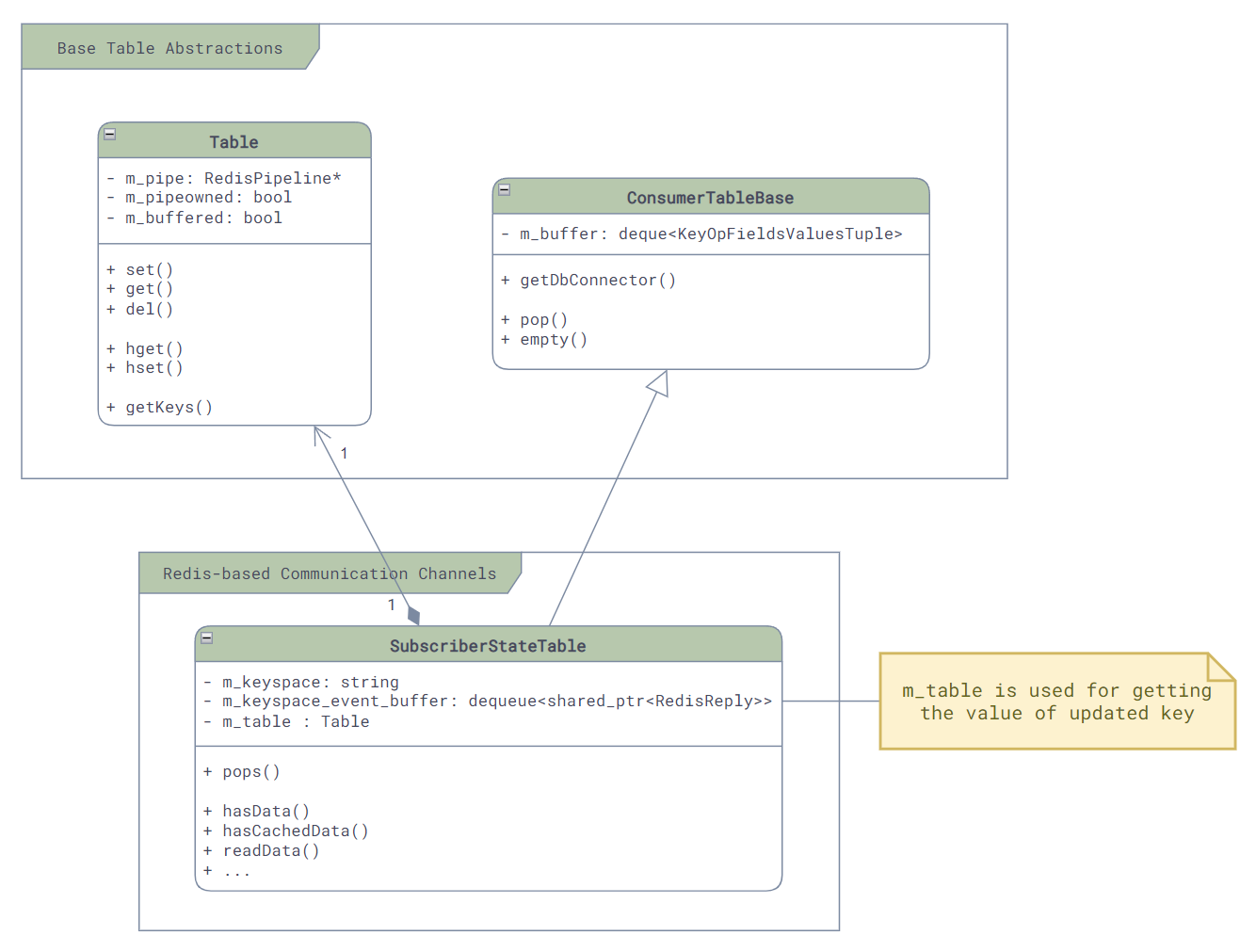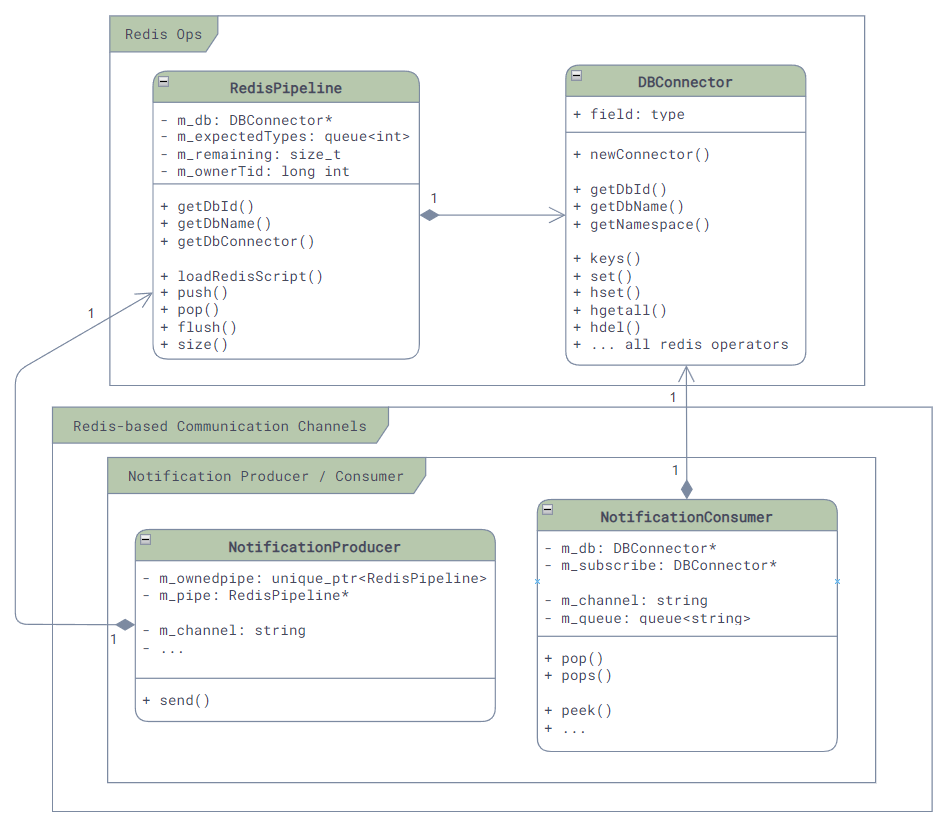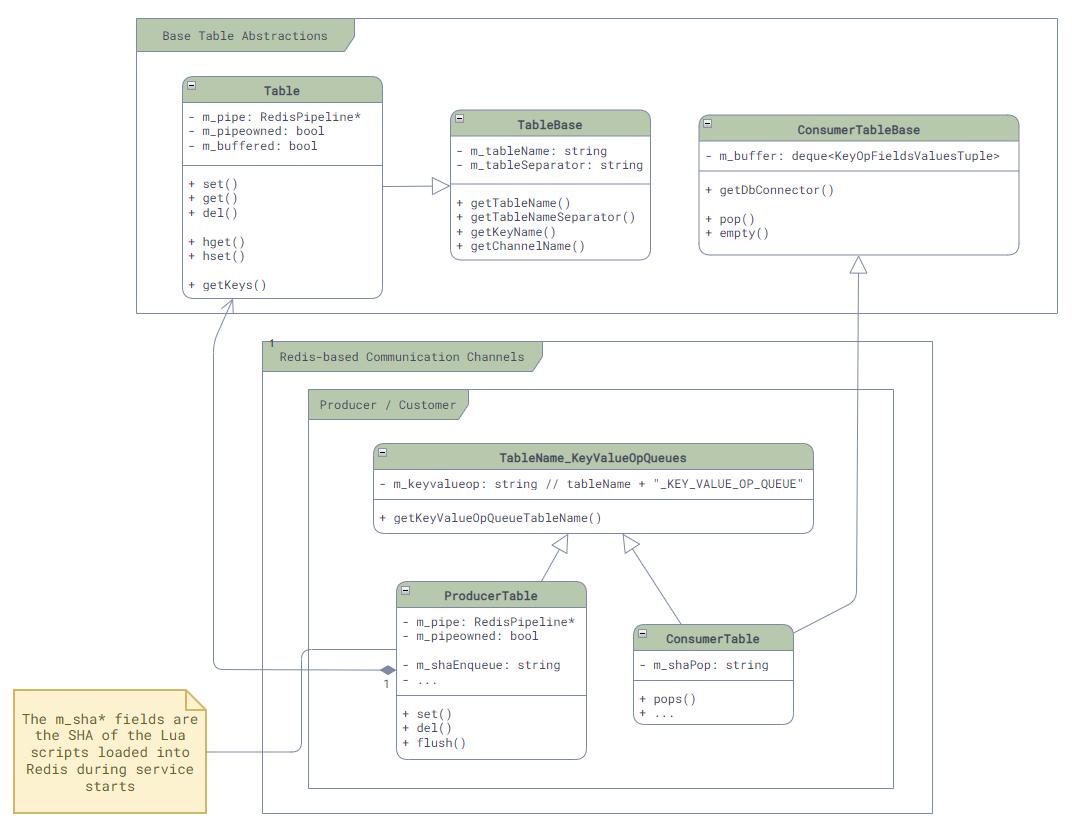通信层
在Redis的封装和表抽象之上,便是SONiC的通信层了,由于需求的不同,这一层中提供了四种不同的PubSub的封装,用于服务间的通信。
SubscribeStateTable
最直接的就是SubscriberStateTable了。
它的原理是利用Redis数据库中自带的keyspace消息通知机制 [4] —— 当数据库中的任何一个key对应的值发生了变化,就会触发Redis发送两个keyspace的事件通知,一个是__keyspace@<db-id>__:<key>下的<op>事件,一个是__keyspace@<db-id>__:<op>下的<key>>事件,比如,在数据库0中删除了一个key,那么就会触发两个事件通知:
PUBLISH __keyspace@0__:foo del
PUBLISH __keyevent@0__:del foo
而SubscriberStateTable就是监听了第一个事件通知,然后调用相应的回调函数。和其直接相关的主要的类的类图如下,这里可以看到它继承了ConsumerTableBase,因为它是Redis的消息的Consumer:

在初始化时,我们可以看到它是如何订阅Redis的事件通知的:
// File: sonic-swss-common - common/subscriberstatetable.cpp
SubscriberStateTable::SubscriberStateTable(DBConnector *db, const string &tableName, int popBatchSize, int pri)
: ConsumerTableBase(db, tableName, popBatchSize, pri), m_table(db, tableName)
{
m_keyspace = "__keyspace@";
m_keyspace += to_string(db->getDbId()) + "__:" + tableName + m_table.getTableNameSeparator() + "*";
psubscribe(m_db, m_keyspace);
// ...
其事件接收和分发主要由两个函数负责:
readData()负责将redis中待读取的事件读取出来,并放入ConsumerTableBase中的队列中pops():负责将队列中的原始事件取出来,并且进行解析,然后通过函数参数传递给调用方
// File: sonic-swss-common - common/subscriberstatetable.cpp
uint64_t SubscriberStateTable::readData()
{
// ...
reply = nullptr;
int status;
do {
status = redisGetReplyFromReader(m_subscribe->getContext(), reinterpret_cast<void**>(&reply));
if(reply != nullptr && status == REDIS_OK) {
m_keyspace_event_buffer.emplace_back(make_shared<RedisReply>(reply));
}
} while(reply != nullptr && status == REDIS_OK);
// ...
return 0;
}
void SubscriberStateTable::pops(deque<KeyOpFieldsValuesTuple> &vkco, const string& /*prefix*/)
{
vkco.clear();
// ...
// Pop from m_keyspace_event_buffer, which is filled by readData()
while (auto event = popEventBuffer()) {
KeyOpFieldsValuesTuple kco;
// Parsing here ...
vkco.push_back(kco);
}
m_keyspace_event_buffer.clear();
}
NotificationProducer / NotificationConsumer
说到消息通信,我们很容易就会联想到消息队列,这就是我们的第二种通信方式 —— NotificationProducer和NotificationConsumer。
这种通信方式通过Redis的自带的PubSub来实现,主要是对PUBLISH和SUBSCRIBE命令的包装,很有限的应用在最简单的通知型的场景中,比如orchagent中的timeout check, restart check之类,非传递用户配置和数据的场景:

这种通信模式下,消息的发送方Producer,主要会做两件事情:一是将消息打包成JSON格式,二是调用Redis的PUBLISH命令将消息发送出去。而且由于PUBLISH命令只能携带一个消息,所以请求中的op和data字段会被放在values的最前面,然后再调用buildJson函数将其打包成一个JSON数组的格式:
int64_t swss::NotificationProducer::send(const std::string &op, const std::string &data, std::vector<FieldValueTuple> &values)
{
// Pack the op and data into values array, then pack everything into a JSON string as the message
FieldValueTuple opdata(op, data);
values.insert(values.begin(), opdata);
std::string msg = JSon::buildJson(values);
values.erase(values.begin());
// Publish message to Redis channel
RedisCommand command;
command.format("PUBLISH %s %s", m_channel.c_str(), msg.c_str());
// ...
RedisReply reply = m_pipe->push(command);
reply.checkReplyType(REDIS_REPLY_INTEGER);
return reply.getReply<long long int>();
}
接收方则是利用SUBSCRIBE命令来接收所有的通知:
void swss::NotificationConsumer::subscribe()
{
// ...
m_subscribe = new DBConnector(m_db->getDbId(),
m_db->getContext()->unix_sock.path,
NOTIFICATION_SUBSCRIBE_TIMEOUT);
// ...
// Subscribe to Redis channel
std::string s = "SUBSCRIBE " + m_channel;
RedisReply r(m_subscribe, s, REDIS_REPLY_ARRAY);
}
ProducerTable / ConsumerTable
我们可以看到NotificationProducer/Consumer实现简单粗暴,但是由于API的限制 [8],它并不适合用来传递数据,所以,SONiC中提供了一种和它非常接近的另外一种基于消息队列的通信机制 —— ProducerTable和ConsumerTable。
这种通信方式通过Redis的List来实现,和Notification不同的地方在于,发布给Channel中的消息非常的简单(单字符"G"),所有的数据都存储在List中,从而解决了Notification中消息大小限制的问题。在SONiC中,它主要用在FlexCounter,syncd服务和ASIC_DB中:
-
消息格式:每条消息都是一个(Key, FieldValuePairs, Op)的三元组,如果用JSON来表达这个消息,那么它的格式如下:(这里的Key是Table中数据的Key,被操作的数据是Hash,所以Field就是Hash中的Field,Value就是Hash中的Value了,也就是说一个消息可以对很多个Field进行操作)
[ "Key", "[\"Field1\", \"Value1\", \"Field2", \"Value2\", ...]", "Op" ] -
Enqueue:ProducerTable通过Lua脚本将消息三元组原子的写入消息队列中(Key =
<table-name>_KEY_VALUE_OP_QUEUE,并且发布更新通知到特定的Channel(Key =<table-name>_CHANNEL)中。 -
Pop:ConsumerTable也通过Lua脚本从消息队列中原子的读取消息三元组,并在读取过程中将其中请求的改动真正的写入到数据库中。
其主要类图如下,这里我们可以看到在ProducerTable中的m_shaEnqueue和ConsumerTable中的m_shaPop,它们就是上面我们提到的这两个Lua脚本在加载时获得的SHA了,而之后我们就可以使用Redis的EVALSHA命令对他们进行原子的调用了:

ProducerTable的核心逻辑如下,我们可以看到对Values的JSON打包,和使用EVALSHA来进行Lua脚本的调用:
// File: sonic-swss-common - common/producertable.cpp
ProducerTable::ProducerTable(RedisPipeline *pipeline, const string &tableName, bool buffered)
// ...
{
string luaEnque =
"redis.call('LPUSH', KEYS[1], ARGV[1], ARGV[2], ARGV[3]);"
"redis.call('PUBLISH', KEYS[2], ARGV[4]);";
m_shaEnque = m_pipe->loadRedisScript(luaEnque);
}
void ProducerTable::set(const string &key, const vector<FieldValueTuple> &values, const string &op, const string &prefix)
{
enqueueDbChange(key, JSon::buildJson(values), "S" + op, prefix);
}
void ProducerTable::del(const string &key, const string &op, const string &prefix)
{
enqueueDbChange(key, "{}", "D" + op, prefix);
}
void ProducerTable::enqueueDbChange(const string &key, const string &value, const string &op, const string& /* prefix */)
{
RedisCommand command;
command.format(
"EVALSHA %s 2 %s %s %s %s %s %s",
m_shaEnque.c_str(),
getKeyValueOpQueueTableName().c_str(),
getChannelName(m_pipe->getDbId()).c_str(),
key.c_str(),
value.c_str(),
op.c_str(),
"G");
m_pipe->push(command, REDIS_REPLY_NIL);
}
而另一侧的ConsumerTable就稍稍复杂一点,因为其支持的op类型很多,所以逻辑都写在了一个单独的文件中(common/consumer_table_pops.lua),我们这里就不贴代码了,有兴趣的同学可以自己去看看。
// File: sonic-swss-common - common/consumertable.cpp
ConsumerTable::ConsumerTable(DBConnector *db, const string &tableName, int popBatchSize, int pri)
: ConsumerTableBase(db, tableName, popBatchSize, pri)
, TableName_KeyValueOpQueues(tableName)
, m_modifyRedis(true)
{
std::string luaScript = loadLuaScript("consumer_table_pops.lua");
m_shaPop = loadRedisScript(db, luaScript);
// ...
}
void ConsumerTable::pops(deque<KeyOpFieldsValuesTuple> &vkco, const string &prefix)
{
// Note that here we are processing the messages in bulk with POP_BATCH_SIZE!
RedisCommand command;
command.format(
"EVALSHA %s 2 %s %s %d %d",
m_shaPop.c_str(),
getKeyValueOpQueueTableName().c_str(),
(prefix+getTableName()).c_str(),
POP_BATCH_SIZE,
RedisReply r(m_db, command, REDIS_REPLY_ARRAY);
vkco.clear();
// Parse and pack the messages in bulk
// ...
}
ProducerStateTable / ConsumerStateTable
Producer/ConsumerTable虽然直观,而且保序,但是它一个消息只能处理一个Key,并且还需要JSON的序列化,然而很多时候我们并用不到保序的功能,反而更需要更大的吞吐量,所以为了优化性能,SONiC就引入了第四种通信方式,也是最常用的通信方式:ProducerStateTable和ConsumerStateTable。
与ProducerTable不同,ProducerStateTable使用Hash的方式来存储消息,而不是List。这样虽然不能保证消息的顺序,但是却可以很好的提升性能!首先,我们省下了JSON的序列化的开销,其次,对于同一个Key下的相同的Field如果被变更多次,那么只需要保留最后一次的变更,这样就将关于这个Key的所有变更消息就合并成了一条,减少了很多不必要的消息处理。
Producer/ConsumerStateTable的底层实现相比于Producer/ConsumerTable也更加复杂一些。其相关联的类的主要类图如下,这里我们依然可以看到它的实现是通过EVALSHA调用Lua脚本来实现的,m_shaSet和m_shaDel就是用来存放修改和发送消息的,而另一边m_shaPop就是用来获取消息的:

在传递消息时:
-
首先,每个消息会被存放成两个部分:一个是KEY_SET,用来保存当前有哪些Key发生了修改,它以Set的形式存放在
<table-name_KEY_SET>的key下,另一个是所有被修改的Key的内容,它以Hash的形式存放在_<redis-key-name>的key下。 -
然后,消息存放之后Producer如果发现是新的Key,那么就是调用
PUBLISH命令,来通知<table-name>_CHANNEL@<db-id>Channel,有新的Key出现了。// File: sonic-swss-common - common/producerstatetable.cpp ProducerStateTable::ProducerStateTable(RedisPipeline *pipeline, const string &tableName, bool buffered) : TableBase(tableName, SonicDBConfig::getSeparator(pipeline->getDBConnector())) , TableName_KeySet(tableName) // ... { string luaSet = "local added = redis.call('SADD', KEYS[2], ARGV[2])\n" "for i = 0, #KEYS - 3 do\n" " redis.call('HSET', KEYS[3 + i], ARGV[3 + i * 2], ARGV[4 + i * 2])\n" "end\n" " if added > 0 then \n" " redis.call('PUBLISH', KEYS[1], ARGV[1])\n" "end\n"; m_shaSet = m_pipe->loadRedisScript(luaSet); -
最后,Consumer会通过
SUBSCRIBE命令来订阅<table-name>_CHANNEL@<db-id>Channel,一旦有新的消息到来,就会使用Lua脚本调用HGETALL命令来获取所有的Key,并将其中的值读取出来并真正的写入到数据库中去。ConsumerStateTable::ConsumerStateTable(DBConnector *db, const std::string &tableName, int popBatchSize, int pri) : ConsumerTableBase(db, tableName, popBatchSize, pri) , TableName_KeySet(tableName) { std::string luaScript = loadLuaScript("consumer_state_table_pops.lua"); m_shaPop = loadRedisScript(db, luaScript); // ... subscribe(m_db, getChannelName(m_db->getDbId())); // ...
为了方便理解,我们这里举一个例子:启用Port Ethernet0:
-
首先,我们在命令行下调用
config interface startup Ethernet0来启用Ethernet0,这会导致portmgrd通过ProducerStateTable向APP_DB发送状态更新消息,如下:EVALSHA "<hash-of-set-lua>" "6" "PORT_TABLE_CHANNEL@0" "PORT_TABLE_KEY_SET" "_PORT_TABLE:Ethernet0" "_PORT_TABLE:Ethernet0" "_PORT_TABLE:Ethernet0" "_PORT_TABLE:Ethernet0" "G" "Ethernet0" "alias" "Ethernet5/1" "index" "5" "lanes" "9,10,11,12" "speed" "40000"这个命令会在其中调用如下的命令来创建和发布消息:
SADD "PORT_TABLE_KEY_SET" "_PORT_TABLE:Ethernet0" HSET "_PORT_TABLE:Ethernet0" "alias" "Ethernet5/1" HSET "_PORT_TABLE:Ethernet0" "index" "5" HSET "_PORT_TABLE:Ethernet0" "lanes" "9,10,11,12" HSET "_PORT_TABLE:Ethernet0" "speed" "40000" PUBLISH "PORT_TABLE_CHANNEL@0" "_PORT_TABLE:Ethernet0"所以最终这个消息会在APPL_DB中被存放成如下的形式:
PORT_TABLE_KEY_SET: _PORT_TABLE:Ethernet0 _PORT_TABLE:Ethernet0: alias: Ethernet5/1 index: 5 lanes: 9,10,11,12 speed: 40000 -
当ConsumerStateTable收到消息后,也会调用
EVALSHA命令来执行Lua脚本,如下:EVALSHA "<hash-of-pop-lua>" "3" "PORT_TABLE_KEY_SET" "PORT_TABLE:" "PORT_TABLE_DEL_SET" "8192" "_"和Producer类似,这个脚本会执行如下命令,将
PORT_TABLE_KEY_SET中的key,也就是_PORT_TABLE:Ethernet0读取出来,然后再将其对应的Hash读取出来,并更新到PORT_TABLE:Ethernet0去,同时将_PORT_TABLE:Ethernet0从数据库和PORT_TABLE_KEY_SET中删除。SPOP "PORT_TABLE_KEY_SET" "_PORT_TABLE:Ethernet0" HGETALL "_PORT_TABLE:Ethernet0" HSET "PORT_TABLE:Ethernet0" "alias" "Ethernet5/1" HSET "PORT_TABLE:Ethernet0" "index" "5" HSET "PORT_TABLE:Ethernet0" "lanes" "9,10,11,12" HSET "PORT_TABLE:Ethernet0" "speed" "40000" DEL "_PORT_TABLE:Ethernet0"到这里,数据的更新才算是完成了。
参考资料
- SONiC Architecture
- Github repo: sonic-swss
- Github repo: sonic-swss-common
- Redis keyspace notifications
- Redis Transactions
- Redis Atomicity with Lua
- Redis hashes
- Redis client handling